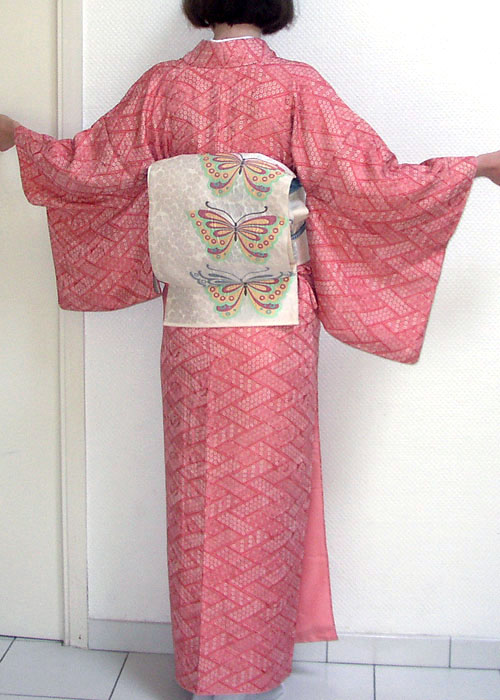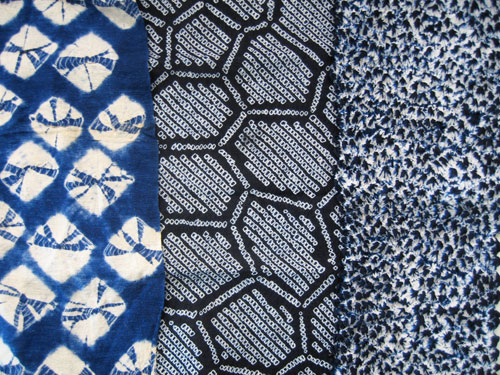I've been putting this off for too long now, as I feel that my knowledge in this field is lacking, but I'm giving it a go in any case. Since I have now proclamed my lack of knowledge, please understand that mistakes are possible and if you know better than me, you are free to correct me. Thank you for understanding.
Dyed patterns on a kimono
Ai-zome is indigo dyeing. The basic material for this dye comes from the leaf of the polygonym tinctorium plant. The japanese method to extract the dye is different than that in the world.
Kosoen.com has a good explanation on how the dye is processed and made. Indigo dyes are mostly used in yukata.
Bingata originates in the Okinawa and the Ryukyu Kingdom (c. 14th century). The term "bingata" does not appear in the old documents and it was called the katachichi (to apply patterns) or hana-nunu (flower cloth). The first person to call this fabric bingata was Iha Fuyu (1876-1947), which means that as a term, bingata is a rather new, but as a fabric dyeing technique, it is an old one.
Read more about bingata in
jahitchcock.com
Edo komon became popular when Edo (modern day Tokyo) became the centre of komon production. Especially komon pattern made from small pinpoint dots. The pattern is made by forcing rice paste through a small stencil, making a pattern of small dots, and then dying the backgroung fabric. The rice paste keeps the pattern white while the rest of the fabric takes the dye. In early Edo period the colors for Edo komon were mainly indigo-white.
About Edo Komon has a detailed information on the process on making an Edo komon kimono.
Shibori is the general term for several types of tie-dye dyeing. The fabric can be binded, stitched, folded, twisted, compressed or capped. Even I know that wikipedia is a bad place to use as information goes, but the
shibori section does list a few shibori technique names and explanations. How reliable these are, I cannot say for sure, so read with causion.
Yuzen is a starch-resist dyeing technique invented by Miyazaki Yuzen during the Genrokuera (1688-1704) of Edo period. The technique uses glutinous rice as the resist, which allows the freestyle design. Yuzen has watercolor like patterns and harmoniously blending colors. The realistic touches on the pattern finishes the look. Short History of Yuzen Dyeing foundable
here.
Hachijou is listed in the Book Of Kimono by Norio Yamaka as a yellow cloth first made in the Hachijou island near Tokyo. There are three kind of hachijou colors: bright yellow Kihachijou color is produced from a dye extracted from the kariyasu grass, the brown Tobihachijou comes from the madami plant and the black Kurohachijou dye comes from the bark of the chinquapin. Characteristic design for these kimono are stripes or checks, in either plain weave or twill.
 |
| Kihachijou kimono from here |
Keiichi Takasawa lists these next terms in his book Kimono: A pictorial story of the kimono (1948):
Conserning general dyeing process:
Shinzen vat-dyeing in single color
Nassen print dyeing, using copper roller
Nukizome dyeing with colored paste
Hikizome dyeing with brush and stencilled papers
Surizome dyeing by rubbing over stencils
Sosogikomizome dyeing as in the popular tenugui towel
Kakizome designs hand painted with dyes by artists
Kukurizome tying with threads and dyeing
Kouketsuzome Another name for kukurizome
Suminagashi dyeing in the "grain of wood" pattern
Rouketsuzome dyeing with wax, like Javanese batik
Kirifukizome dyeing with sprayer
Tsutsuhiki dyeing with a paste tube
Kureonzome dyeing with crayons.
Conserning kimono patterning:
Soumoyo all over pattern
Susomoyo hem pattern
Uramoyo lining pattern
Semoyo back pattern
Yagasuri scattered arrow-shaped figures
Sharyou fretwork
Ichimatsu chequered
Sambenkoshi three bar fretwork
Dandara checkers
Asanoha hemp leaf
The kukurizome and the kouketsuzome seem to be some kind of shibori techniques. I had never heard some of these terms before I got these books and I do not know if they are still in use. I listed them here incase someone has come against there terms and wasn't sure what they meant. The book was published 1948 so some of these terms might not be in use anymore. I'm still doing research on these, so I'm sorry I cannot provide more information on these. They are fascinating thou.

.jpg)






Ei kommentteja:
Lähetä kommentti